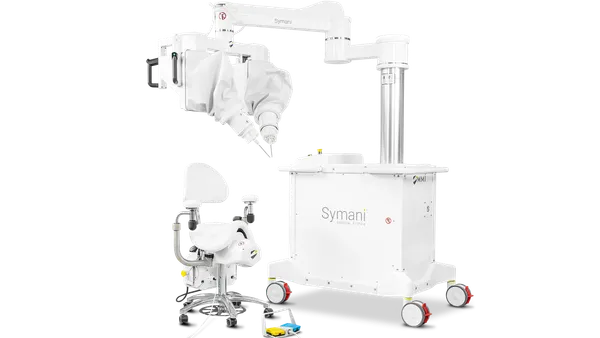It was a busy year for medtech, from the U.S.-China trade war threatening to hit $2.8 billion worth of imaging equipment and other devices to FDA Commissioner Scott Gottlieb's pitches to revamp premarket authorization pathways and postmarket surveillance practices.
Meanwhile, the impending 2020 EU transition to its new medical devices and in-vitro diagnostics regulations was top of mind for industry, as they sought to navigate product recertification with the uncertain logistics and wildcard of Brexit looming.
In sunnier Silicon Valley, digital health funding boomed in 2018. Federal initiatives tied to the trend, like FDA's software Pre-Cert pilot and CMS' Blue Button 2.0 program for app development, boosted the medtech profiles of relative newcomers like Pear Therapeutics, Tidepool, and Google-backed Verily. A growing focus on FDA reviews of mobile health applications expanded the everyday consumer reach of technologies like electrocardiograms, now available in the Apple Watch.
Before diving into next year, we curated this list of our most notable stories from 2018:
Top 10 Stories of 2018
-
FDA rarely uses its power to recall dangerous medical devices. Why not?
Since the time this Deep Dive on recalls caught reader attention in August, damning reports on device safety from the International Consortium of Investigative Journalists prompted renewed scrutiny of regulatory actions worldwide. FDA followed the negative press with proposed reforms addressing its highly-trafficked 510(k) pathway, and just before that, called for funding for the National Evaluation System for health Technology, which would oversee real-world data collection as a more vigilant, proactive method of postmarket surveillance. Read More »
-
Medical device industry caught in US-China trade war
Medtech companies couldn't escape tit-for-tat tariffs this year. But device manufacturers know that the U.S.'s 25% tariff on $836 million in medical technology imports from China could have been worse. Industry successfully lobbied to bring that figure down from nearly $2.8 billion in April.
In September, AdvaMed CEO Scott Whitaker noted that any losses inflicted by the trade war went beyond brand name device companies. "Depending on where you sit on medtech, whether on imaging or other spaces, you'll have more of a direct impact because of component parts," he said. Read More » -
New Apple Watch adds FDA-cleared ECG application
While the Apple Watch has been commonly used as a fitness or sleep tracker since its rollout in 2015, it wasn't until this month that the wearable device offered built-in electrocardiogram and atrial fibrillation detection capability. The added features heightened Apple's profile in the eyes of the healthcare world, as did news of there being at least 40 doctors within the company's staff. Garmin and Fitbit will look to keep up with Apple and push the boundaries of wearables as high-tech wellness tools in the coming year. Further advancements will more clearly define the line between which digital health applications FDA will and won't regulate. Read More »
-
5 sticking points in the EU medical device reg transition
The EU regulatory overhaul was chosen as MedTech Dive's Disruption of the Year in-part for the massive headache the crackdown has caused for medtech companies. The clock is ticking for an estimated 314,000 products that must complete recertification by the May 2020 MDR implementation date in order to continue European sales. Regulatory situation in Europe for device companies has been further complicated by a less-than-smooth Brexit planning process, with the U.K. government going so far as to issue a "worst-case" plan for device companies, should it fail to secure a deal to remain in the EU medicines and medical devices regulatory networks by March 29, 2019. Read More »
-
IVCT legislation moves closer to finish line
"We should have a consistent approach for all in-vitro clinical tests," FDA Commissioner Scott Gottlieb said in September. "Our approach needs to be the same whether the test developer is a traditional manufacturer or a clinical laboratory." Building off 2017's Diagnostic Accuracy and Innovation Act, earlier this month a bipartisan group of senators and representatives released draft legislation to push FDA in this direction, among other provisions that would create a precertification pathway for tests and give FDA heavier authority to quickly pull questionable tests off the market. Read More »
-
FDA moves toward "modernized" 510(k) pathway
The vast majority of premarket device authorizations happen through the 510(k) pathway; MedTech Dive calculated a rate of 97% in 2017. FDA's work on the 510(k) process in 2018 was all about streamlined efficiency... yet also about stricter oversight.
In September, FDA issued final guidance for industry on risk-benefit considerations in 510(k) applications. Responding to a mandate in the FDA Reauthorization Act of 2017, FDA also sought to unclog its review pipeline by delineating which low- to moderate-risk devices could simply be reviewed by a third-party instead. In the same month, the agency rolled out "Quik," or the Quality in 510(k) Review program, to potentially shorten review times by implementing the use of eSubmitter software.
In a similar vein in October, FDA launched a Special 510(k) pilot to shorten review times for minor changes to devices. The cherry on top was a goal announced by FDA in November to sunset device predicates older than 10 years, an initiative it intends to help along by establishing new predicates through increased use of the De Novo pathway. However, it's unclear whether Congress will ever empower FDA with the legal authority to de-validate those older model predicates. -
Industry balks at FDA’s cybersecurity plans
With crippling health system ransomware attacks top of mind, cybersecurity was a widely discussed healthcare worry in 2018. While hospitals are often the victim of these network-wide attacks, regulators are increasingly wary of bad actors hacking into individual devices, such as pacemakers. HHS' Office of Inspector General called out FDA's preparedness against such attacks as "deficient."
Building on points in April's Medical Device Safety Action Plan from FDA, earlier this month the House Energy and Commerce Committee released recommendations to bolster healthcare cybersecurity, including the widespread adoption of coordinated disclosure programs, supporting open-source software and the oft-discussed implementation of a software bill of materials across connected technologies, which HHS plans to formally discuss in February of next year. Read More »
-
Why political contributions linked to a little-known hearing aid firm topped medtech giants
Run-of-the-mill lobbying by the medtech industry to repeal the medical device tax has been unsurprising. But outsized political spending by a company that makes hearing aids? Unexpected. This Deep Dive showed the lengths a niche medtech sector went to to protect its specialty business. Read More »
-
Robotic surgery market is about to get crowded, report says
A space long-dominated by Intuitive Surgical's da Vinci products, robotic surgery has piqued the interest of medtech giants now racing to catch up, like Johnson & Johnson, Stryker and Medtronic, which closed a $1.7 billion acquisition of a robot-assisted spinal surgery system on Dec. 19. Intuitive, whose business has grown in 2018, has not been immune to device safety blowback, drawing a sharp eye from NBC Nightly News in December regarding the minimal training required before surgeons operate the robots in procedures.
Read More » -
5 takeaways amid new scrutiny of FDA medical device oversight
An unflattering, end-of-year spotlight on device safety, largely spurred by publicized investigative reports from ICIJ's partners, renewed discussions of consumer protection. We unpacked what the swell of activism may mean in the coming months, including possibilities for stricter oversight by FDA and Congress, and increased pressure to stand up NEST and require the use of Unique Device Identifiers in insurance claims data. Read More »













